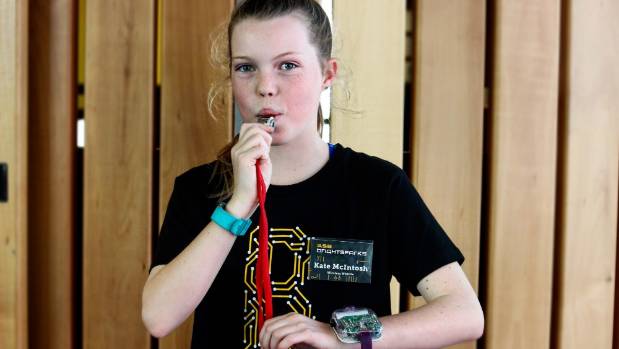Kate McIntosh's wireless whistle for hearing-impaired athletes won a national inventors competition. SHANI WILLIAMS/STUFF
Two Auckland teenagers have wowed judges with their inventions at a national technology competition.
Brian Kitchen, 13, invented a laser scanner that creates 3D models of lava caves and Kate McIntosh, 12, created a wireless whistle to help hearing-impaired athletes play team sports.
The students were both awarded the supreme innovator title at the ASB Bright Sparks competition's 17th annual prizegiving at Auckland's waterfront on Tuesday night.
The ASB Bright Sparks is a national technology and innovation competition open to intermediate and high school students across New Zealand.
McIntosh from Northcross Intermediate said it was playing water polo that inspired her to create the wireless whistle.
When the referee's whistle is blown the wireless whistle sends a signal to a vibrating wristband, letting the hearing-impaired wearer know it is time to pause the game.
"I was playing water polo and my friend was sent off for playing past the whistle. It got me thinking – what would athletes do if they could not hear properly?" McIntosh said.
"I wanted to create something that would help all players hear the whistle regardless of if they had perfect hearing or not," she said.
National Foundation for the Deaf chief executive Sue Giddens said she could see McIntosh's invention being adapted for many uses in community activities.
"Hearing loss affects more than 880,000 New Zealanders – so the potential impact of Kate's innovation is exciting. We look forward to seeing her project in development, then in action," Giddens said.
Co-winner Kitchen from Ponsonby Intermediate invented a laser scanner that can inform researchers about how big a cave is and its dimensions.
Kitchen said we live in a city with countless lava caves and he thought it would be cool to have something that could make 3D models of these caves.
The 3D scanner could see up to six meters and provides more reliable results than was currently available to Auckland Council, Kitchen said.
"My science tutor told me that Auckland Council currently only have 2D drawings of Auckland's lava caves, but need to upgrade to 3D where possible," he said.
"My aim was to help build something that would help make this process easier for our council," he said.
Other finalists included a machine that can detect if someone has asthma, a device that records the impact that an athlete's head is exposed to during impact sports like rugby and a security system to be deployed in a natural disaster.
– Stuff
